Angela Dai
DiffuMatch: Category-Agnostic Spectral Diffusion Priors for Robust Non-rigid Shape Matching
Jul 31, 2025Abstract:Deep functional maps have recently emerged as a powerful tool for solving non-rigid shape correspondence tasks. Methods that use this approach combine the power and flexibility of the functional map framework, with data-driven learning for improved accuracy and generality. However, most existing methods in this area restrict the learning aspect only to the feature functions and still rely on axiomatic modeling for formulating the training loss or for functional map regularization inside the networks. This limits both the accuracy and the applicability of the resulting approaches only to scenarios where assumptions of the axiomatic models hold. In this work, we show, for the first time, that both in-network regularization and functional map training can be replaced with data-driven methods. For this, we first train a generative model of functional maps in the spectral domain using score-based generative modeling, built from a large collection of high-quality maps. We then exploit the resulting model to promote the structural properties of ground truth functional maps on new shape collections. Remarkably, we demonstrate that the learned models are category-agnostic, and can fully replace commonly used strategies such as enforcing Laplacian commutativity or orthogonality of functional maps. Our key technical contribution is a novel distillation strategy from diffusion models in the spectral domain. Experiments demonstrate that our learned regularization leads to better results than axiomatic approaches for zero-shot non-rigid shape matching. Our code is available at: https://github.com/daidedou/diffumatch/
HOI-PAGE: Zero-Shot Human-Object Interaction Generation with Part Affordance Guidance
Jun 08, 2025Abstract:We present HOI-PAGE, a new approach to synthesizing 4D human-object interactions (HOIs) from text prompts in a zero-shot fashion, driven by part-level affordance reasoning. In contrast to prior works that focus on global, whole body-object motion for 4D HOI synthesis, we observe that generating realistic and diverse HOIs requires a finer-grained understanding -- at the level of how human body parts engage with object parts. We thus introduce Part Affordance Graphs (PAGs), a structured HOI representation distilled from large language models (LLMs) that encodes fine-grained part information along with contact relations. We then use these PAGs to guide a three-stage synthesis: first, decomposing input 3D objects into geometric parts; then, generating reference HOI videos from text prompts, from which we extract part-based motion constraints; finally, optimizing for 4D HOI motion sequences that not only mimic the reference dynamics but also satisfy part-level contact constraints. Extensive experiments show that our approach is flexible and capable of generating complex multi-object or multi-person interaction sequences, with significantly improved realism and text alignment for zero-shot 4D HOI generation.
TUM2TWIN: Introducing the Large-Scale Multimodal Urban Digital Twin Benchmark Dataset
May 13, 2025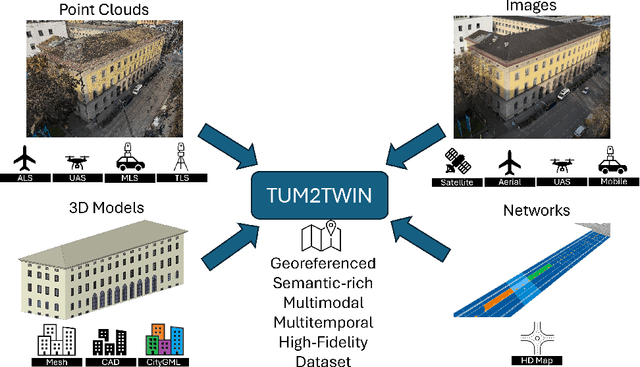

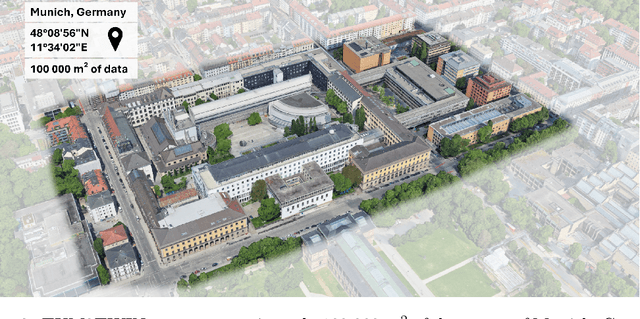
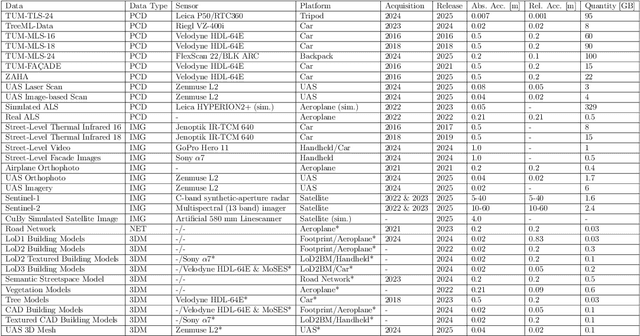
Abstract:Urban Digital Twins (UDTs) have become essential for managing cities and integrating complex, heterogeneous data from diverse sources. Creating UDTs involves challenges at multiple process stages, including acquiring accurate 3D source data, reconstructing high-fidelity 3D models, maintaining models' updates, and ensuring seamless interoperability to downstream tasks. Current datasets are usually limited to one part of the processing chain, hampering comprehensive UDTs validation. To address these challenges, we introduce the first comprehensive multimodal Urban Digital Twin benchmark dataset: TUM2TWIN. This dataset includes georeferenced, semantically aligned 3D models and networks along with various terrestrial, mobile, aerial, and satellite observations boasting 32 data subsets over roughly 100,000 $m^2$ and currently 767 GB of data. By ensuring georeferenced indoor-outdoor acquisition, high accuracy, and multimodal data integration, the benchmark supports robust analysis of sensors and the development of advanced reconstruction methods. Additionally, we explore downstream tasks demonstrating the potential of TUM2TWIN, including novel view synthesis of NeRF and Gaussian Splatting, solar potential analysis, point cloud semantic segmentation, and LoD3 building reconstruction. We are convinced this contribution lays a foundation for overcoming current limitations in UDT creation, fostering new research directions and practical solutions for smarter, data-driven urban environments. The project is available under: https://tum2t.win
QuickSplat: Fast 3D Surface Reconstruction via Learned Gaussian Initialization
May 08, 2025Abstract:Surface reconstruction is fundamental to computer vision and graphics, enabling applications in 3D modeling, mixed reality, robotics, and more. Existing approaches based on volumetric rendering obtain promising results, but optimize on a per-scene basis, resulting in a slow optimization that can struggle to model under-observed or textureless regions. We introduce QuickSplat, which learns data-driven priors to generate dense initializations for 2D gaussian splatting optimization of large-scale indoor scenes. This provides a strong starting point for the reconstruction, which accelerates the convergence of the optimization and improves the geometry of flat wall structures. We further learn to jointly estimate the densification and update of the scene parameters during each iteration; our proposed densifier network predicts new Gaussians based on the rendering gradients of existing ones, removing the needs of heuristics for densification. Extensive experiments on large-scale indoor scene reconstruction demonstrate the superiority of our data-driven optimization. Concretely, we accelerate runtime by 8x, while decreasing depth errors by up to 48% in comparison to state of the art methods.
Physically Consistent Humanoid Loco-Manipulation using Latent Diffusion Models
Apr 23, 2025Abstract:This paper uses the capabilities of latent diffusion models (LDMs) to generate realistic RGB human-object interaction scenes to guide humanoid loco-manipulation planning. To do so, we extract from the generated images both the contact locations and robot configurations that are then used inside a whole-body trajectory optimization (TO) formulation to generate physically consistent trajectories for humanoids. We validate our full pipeline in simulation for different long-horizon loco-manipulation scenarios and perform an extensive analysis of the proposed contact and robot configuration extraction pipeline. Our results show that using the information extracted from LDMs, we can generate physically consistent trajectories that require long-horizon reasoning.
ScanEdit: Hierarchically-Guided Functional 3D Scan Editing
Apr 21, 2025
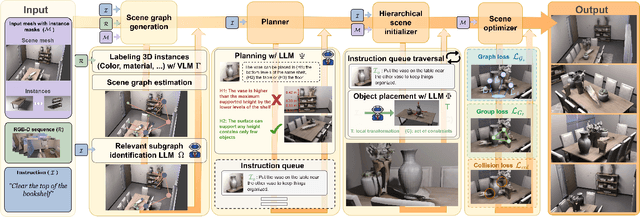

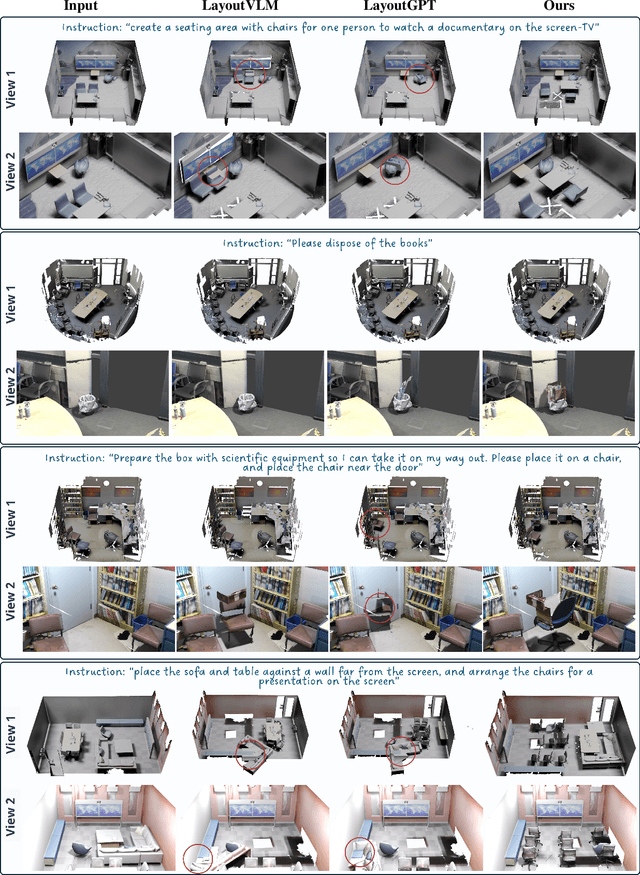
Abstract:With the fast pace of 3D capture technology and resulting abundance of 3D data, effective 3D scene editing becomes essential for a variety of graphics applications. In this work we present ScanEdit, an instruction-driven method for functional editing of complex, real-world 3D scans. To model large and interdependent sets of ob- jectswe propose a hierarchically-guided approach. Given a 3D scan decomposed into its object instances, we first construct a hierarchical scene graph representation to enable effective, tractable editing. We then leverage reason- ing capabilities of Large Language Models (LLMs) and translate high-level language instructions into actionable commands applied hierarchically to the scene graph. Fi- nally, ScanEdit integrates LLM-based guidance with ex- plicit physical constraints and generates realistic scenes where object arrangements obey both physics and common sense. In our extensive experimental evaluation ScanEdit outperforms state of the art and demonstrates excellent re- sults for a variety of real-world scenes and input instruc- tions.
AI Agents in Engineering Design: A Multi-Agent Framework for Aesthetic and Aerodynamic Car Design
Mar 30, 2025Abstract:We introduce the concept of "Design Agents" for engineering applications, particularly focusing on the automotive design process, while emphasizing that our approach can be readily extended to other engineering and design domains. Our framework integrates AI-driven design agents into the traditional engineering workflow, demonstrating how these specialized computational agents interact seamlessly with engineers and designers to augment creativity, enhance efficiency, and significantly accelerate the overall design cycle. By automating and streamlining tasks traditionally performed manually, such as conceptual sketching, styling enhancements, 3D shape retrieval and generative modeling, computational fluid dynamics (CFD) meshing, and aerodynamic simulations, our approach reduces certain aspects of the conventional workflow from weeks and days down to minutes. These agents leverage state-of-the-art vision-language models (VLMs), large language models (LLMs), and geometric deep learning techniques, providing rapid iteration and comprehensive design exploration capabilities. We ground our methodology in industry-standard benchmarks, encompassing a wide variety of conventional automotive designs, and utilize high-fidelity aerodynamic simulations to ensure practical and applicable outcomes. Furthermore, we present design agents that can swiftly and accurately predict simulation outcomes, empowering engineers and designers to engage in more informed design optimization and exploration. This research underscores the transformative potential of integrating advanced generative AI techniques into complex engineering tasks, paving the way for broader adoption and innovation across multiple engineering disciplines.
Animating the Uncaptured: Humanoid Mesh Animation with Video Diffusion Models
Mar 20, 2025Abstract:Animation of humanoid characters is essential in various graphics applications, but requires significant time and cost to create realistic animations. We propose an approach to synthesize 4D animated sequences of input static 3D humanoid meshes, leveraging strong generalized motion priors from generative video models -- as such video models contain powerful motion information covering a wide variety of human motions. From an input static 3D humanoid mesh and a text prompt describing the desired animation, we synthesize a corresponding video conditioned on a rendered image of the 3D mesh. We then employ an underlying SMPL representation to animate the corresponding 3D mesh according to the video-generated motion, based on our motion optimization. This enables a cost-effective and accessible solution to enable the synthesis of diverse and realistic 4D animations.
MeshPad: Interactive Sketch Conditioned Artistic-designed Mesh Generation and Editing
Mar 03, 2025Abstract:We introduce MeshPad, a generative approach that creates 3D meshes from sketch inputs. Building on recent advances in artistic-designed triangle mesh generation, our approach addresses the need for interactive artistic mesh creation. To this end, we focus on enabling consistent edits by decomposing editing into 'deletion' of regions of a mesh, followed by 'addition' of new mesh geometry. Both operations are invoked by simple user edits of a sketch image, facilitating an iterative content creation process and enabling the construction of complex 3D meshes. Our approach is based on a triangle sequence-based mesh representation, exploiting a large Transformer model for mesh triangle addition and deletion. In order to perform edits interactively, we introduce a vertex-aligned speculative prediction strategy on top of our additive mesh generator. This speculator predicts multiple output tokens corresponding to a vertex, thus significantly reducing the computational cost of inference and accelerating the editing process, making it possible to execute each editing step in only a few seconds. Comprehensive experiments demonstrate that MeshPad outperforms state-of-the-art sketch-conditioned mesh generation methods, achieving more than 22% mesh quality improvement in Chamfer distance, and being preferred by 90% of participants in perceptual evaluations.
Use of Winsome Robots for Understanding Human Feedback (UWU)
Feb 07, 2025Abstract:As social robots become more common, many have adopted cute aesthetics aiming to enhance user comfort and acceptance. However, the effect of this aesthetic choice on human feedback in reinforcement learning scenarios remains unclear. Previous research has shown that humans tend to give more positive than negative feedback, which can cause failure to reach optimal robot behavior. We hypothesize that this positive bias may be exacerbated by the robot's level of perceived cuteness. To investigate, we conducted a user study where participants critique a robot's trajectories while it performs a task. We then analyzed the impact of the robot's aesthetic cuteness on the type of participant feedback. Our results suggest that there is a shift in the ratio of positive to negative feedback when perceived cuteness changes. In light of this, we experiment with a stochastic version of TAMER which adapts based on the user's level of positive feedback bias to mitigate these effects.
 Add to Chrome
Add to Chrome Add to Firefox
Add to Firefox Add to Edge
Add to Edge